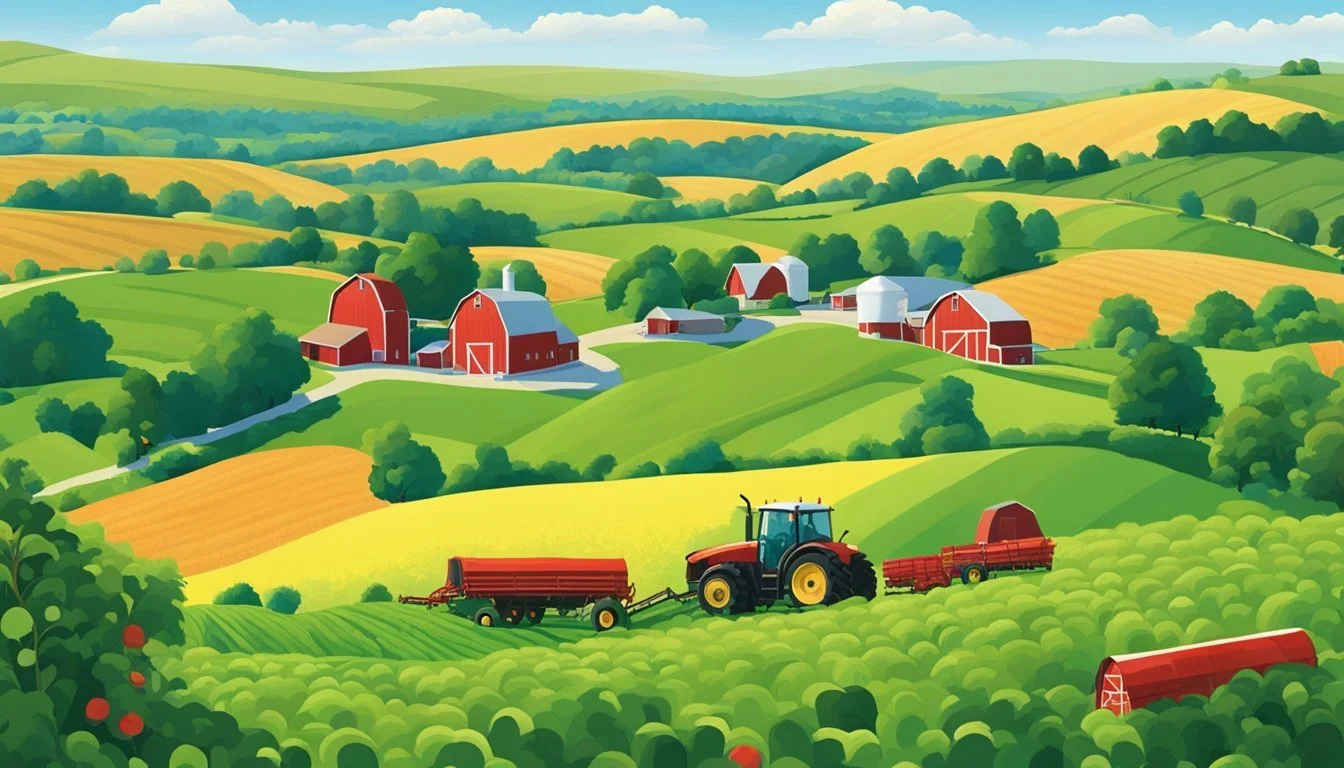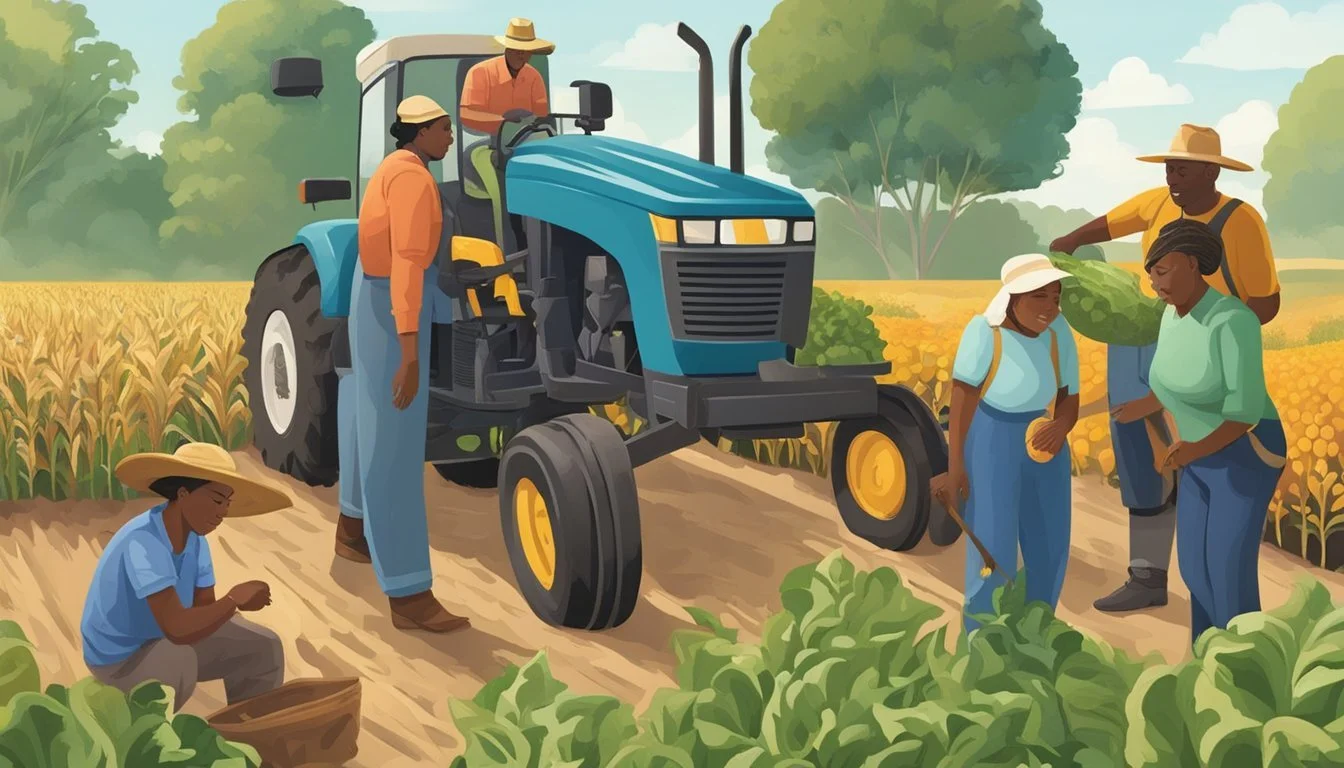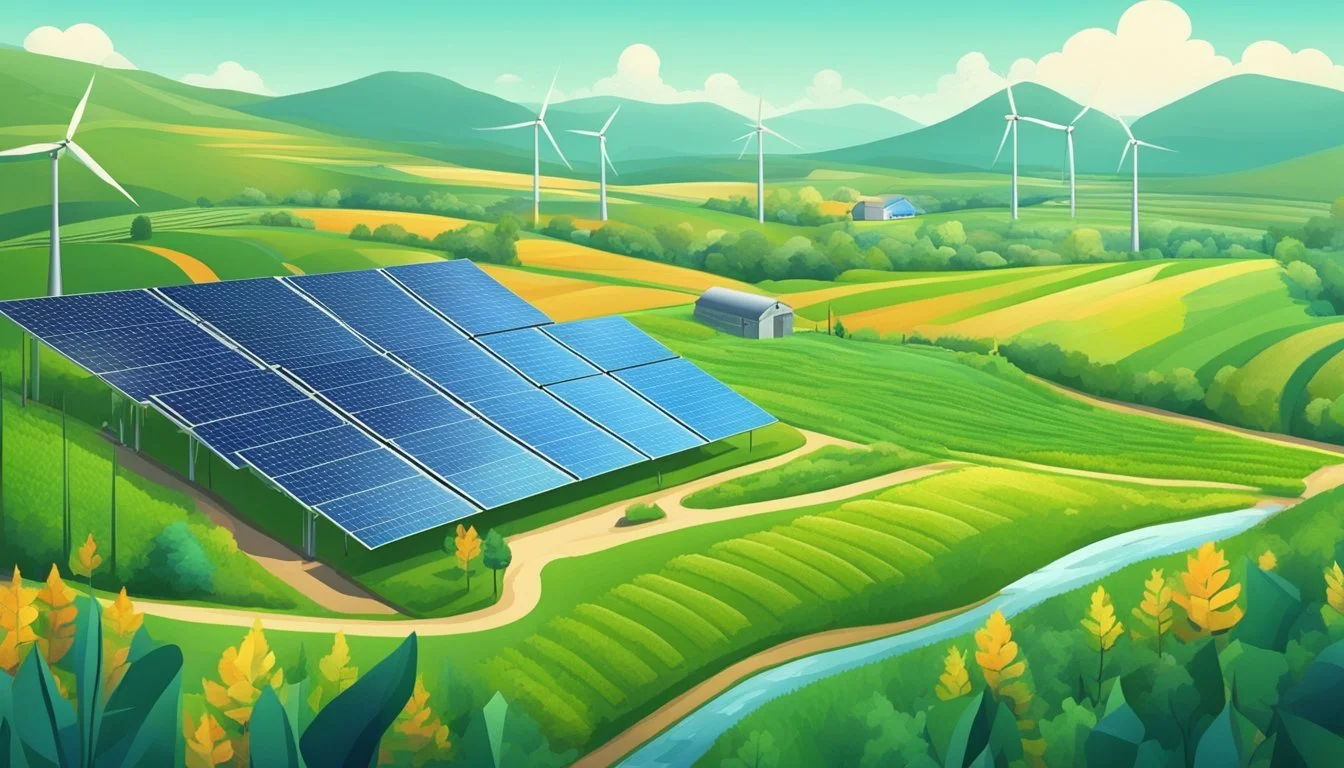Farming Communities in Minnesota
Thriving Amidst Modern Challenges
The farming communities in Minnesota offer a unique blend of rich history, thriving agriculture, and inviting rural charm. From small towns like Sauk Centre, which inspired Sinclair Lewis' depiction of America's original Main Street, to expansive farm properties available for sale, Minnesota's farming landscape is diverse and vibrant. Nestled among the state’s rolling plains and fertile soil, these communities embody the essence of rural America while continuing to adapt to modern agricultural practices.
Minnesota stands out as a leading state with a substantial amount of its land dedicated to farming, supported by robust USDA programs. This commitment to agriculture is evident in regions with significant farmland, as reported by the Farm Service Agency. These areas not only produce essential crops but also serve as a backbone for the state's economy and culture.
Home seekers and agricultural enthusiasts can discover numerous opportunities within Minnesota’s farm towns. With properties ranging from historical farmhouses to newly constructed homes, there is something for everyone looking to embrace the agricultural lifestyle. Whether it’s through attending local auctions or exploring listings on platforms like Zillow and realtor.com, the charm and potential of Minnesota's farming communities invite exploration and investment.
History of Farming in Minnesota
Minnesota's farming history reflects a transformation from small family farms to significant agricultural advancements, providing a comprehensive view of changes over the centuries.
Early Agriculture
In the early 1800s, agriculture in Minnesota began with Euro-American settlers. The Homestead Act of 1862 played a crucial role, attracting 75,000 settlers within three years by offering 160 acres of free land if they farmed it for five years. Early farmers primarily focused on subsistence farming, growing food for their families and livestock. Wheat became predominant by the 1870s, transforming the state into a breadbasket. Wendelin Grimm's introduction of alfalfa or "everlasting clover" in 1857 marked the beginning of innovative crop farming, crucial for dairy cattle feed.
Industrial Advancements
The period between 1900 and 1955 saw significant changes in Minnesota agriculture. During this era, technological advancements transformed farming practices. The Dust Bowl in the 1930s, exacerbated by intensive grazing and plowing, caused severe soil erosion and forced many farmers out of business. Mechanization played a pivotal role, with tractors and other machinery replacing horses, increasing efficiency, and reducing manual labor. Advances in crop science and fertilizers also boosted productivity. Despite the setbacks, these innovations helped stabilize and eventually grow farming activities, setting the stage for modern agricultural practices.
The Modern Landscape
Today, Minnesota's agricultural landscape is diverse and highly productive. Small family farms have often given way to larger, more specialized operations. The state is a leading producer of corn, soybeans, sugar beets, and dairy products. Modern techniques such as precision farming, which uses GPS and data analytics, optimize crop yields and resource use. Sustainable practices have also become more prevalent, addressing concerns about environmental impact and long-term soil health. This evolution reflects a balance between maintaining productivity and ensuring the sustainability of the land for future generations.
Geography and Climate Influence
Geography and climate play a crucial role in shaping the farming communities in Minnesota. The diverse landscapes and changing weather patterns impact agricultural practices and economic outcomes across the state.
Regional Farming Characteristics
Minnesota's farming characteristics vary significantly by region. In Central Minnesota, fertile plains and a moderate climate support the cultivation of crops like corn, soybeans, and sugar beets. Southern Minnesota is rich in loam soils, making it ideal for dairy farming, hog production, and row crops.
The Red River Valley in the northwest is known for its productive clay soils, specializing in crops such as wheat, barley, and legumes. The southeast's karst topography contributes to large-scale dairy operations and crop rotations. These regional differences provide varying opportunities and challenges for local farmers.
Climate Change Effects
Climate change significantly impacts agriculture in Minnesota, altering precipitation patterns and temperature extremes. Increased rainfall and flooding present challenges for planting and harvesting seasons, particularly in Central Minnesota. Additionally, warmer temperatures contribute to longer growing seasons but also elevate the risks of pest infestations and crop diseases.
Farmers are adopting practices like cover cropping and conservation tillage to mitigate these effects. The state has seen a rise in the use of cover crops, which help improve soil health and manage water runoff. These adaptations are crucial for sustaining the countryside and ensuring the long-term viability of Minnesota's agricultural sector amidst changing climatic conditions.
Economic Impact
Minnesota's farming communities contribute significantly to the state’s economy through direct financial contributions and employment opportunities. Analyzing these aspects provides insight into their economic importance.
Contribution to State Economy
Farming communities in Minnesota play a vital role in the state’s economy. The agricultural and forestry sectors contribute about $21.4 billion to household income. Of this, processing and other agricultural activities account for approximately $7.2 billion.
The state ranks high nationally in agricultural production, placing sixth in overall agriculture and fifth in crop production. Key products include sugar beets, turkeys, and green peas, highlighting the diverse nature of Minnesota's agricultural sector. These contributions underscore the economic value these communities bring.
Employment and Jobs
Employment in Minnesota's farming communities is significant. The agricultural sector provides numerous job opportunities, ranging from crop production to livestock management. As of recent reports, earnings per job in rural areas show substantial growth, with entirely rural groups experiencing a 59% increase in earnings since 2001.
Additionally, average farm sizes in Minnesota are around 379 acres, creating a need for a substantial workforce. The presence of diverse agricultural products means a variety of jobs, supporting both direct and indirect employment in the region. This employment bolsters local economies and sustains rural communities.
Demographics and Diversity in Farming
Farming communities in Minnesota are experiencing shifts in demographics and growing diversity. There is an increase in the number of non-traditional farmers and efforts to support underserved communities to ensure a more inclusive agricultural future.
Changing Faces of Minnesota Farmers
Minnesota's agricultural sector has traditionally been dominated by white male farmers. Recent trends indicate a shift towards greater diversity.
The last USDA census found that less than 1 percent of Minnesota farmers were Black, Indigenous, or from other minority groups. Women and veterans are also emerging as significant contributors to Minnesota farming. Initiatives to support individuals with disabilities in agriculture are also gaining traction.
These changes reflect broader societal shifts and efforts towards inclusiveness and equity in farming communities.
Supporting Underserved Communities
Minnesota has recognized the need to support underserved farming communities. Programs focus on Emerging Farmers, providing resources and training to help non-traditional farmers succeed.
Efforts include financial support, access to land, and technical assistance. The state aims to make farming accessible for Black, Indigenous, women, veterans, and persons with disabilities.
These initiatives are essential for building a resilient and diverse agricultural sector. Increasing participation from these groups enriches the farming community and promotes sustainable practices.
Agricultural Education and Assistance
Farming communities in Minnesota benefit greatly from various educational programs and assistance initiatives designed to support agricultural growth and sustainability. This section explores primary education programs and resources for continued learning available to these communities.
Primary Education Programs
Minnesota offers several primary education programs focusing on agricultural education for youth. One such program is the Farm to School initiative, which integrates local agriculture into schools' curriculums. It promotes healthy eating and supports the local farm economy.
Another significant program is the youth agricultural education grants provided by the Land Stewardship Project. These grants help organizations and communities acquire resources to promote agricultural education for urban youth.
Fond du Lac Tribal and Community College plays a critical role by offering programs that combine traditional knowledge with modern agricultural practices. This provides students with comprehensive agricultural education grounded in both scientific and cultural perspectives.
Continued Learning and Resources
Continued learning and resources for Minnesota's farming communities include grants, technical assistance, and support for educational institutions. The Minnesota Agricultural Education Leadership Council (MAELC) provides grants to improve agricultural education, focusing on strategic initiatives and community collaboration. This ensures that educators and institutions can continuously enhance their agricultural programs.
Community Development Financial Institutions (CDFIs) also offer technical assistance to increase their capacity to serve farmers. This includes developing agriculture lending programs and building internal knowledge to provide essential financial services to farmers.
Additionally, the Minnesota Department of Agriculture offers the Farm to School and Early Care Grants, supporting school districts and early childhood education centers. These grants help to buy and serve local agricultural products, fostering a connection between education and local farming.
Educational resources and support systems create a robust framework that empowers farming communities through continued learning and practical assistance. This comprehensive approach ensures long-term sustainability and growth for Minnesota's agricultural sector.
Innovative Farming Practices
Farming communities in Minnesota are embracing various innovative practices to enhance sustainability and efficiency. These methods, ranging from sustainable agriculture to advanced technological applications, address pressing concerns such as soil health and resource management.
Sustainable Agriculture
Minnesota farmers are increasingly adopting practices like cover cropping and interseeding. These techniques help in maintaining soil structure and preventing erosion.
Cover crops are planted between regular crops and are left in the field after harvest. These plants enrich the soil with organic matter and act as forage for cattle. Interseeding involves planting cover crops alongside main crops such as corn, offering continuous ground cover.
The Nature Conservancy and other organizations are promoting policies and funding to support these sustainable methods. Emphasis on indigenous wisdom and land stewardship ensures that ecological balance is maintained, advising on crop rotation and minimal chemical use.
Technology in Farming
Technology is revolutionizing farming in Minnesota by enhancing productivity and sustainability through advanced tools and techniques. Precision agriculture uses sensors, GPS, and data analytics to optimize planting, watering, and harvesting.
Drones are used for aerial surveys, allowing for real-time crop monitoring and early detection of issues like pest infestations. Machinery with GPS-guided systems helps in precise planting and efficient use of resources.
Innovative seed varieties developed through biotechnology are also becoming prevalent. These seeds are engineered to withstand pests and adverse weather conditions, reducing the reliance on chemical treatments and increasing yields.
Automation in equipment, such as self-driving tractors, simplifies labor-intensive tasks, making farming more efficient and cost-effective. These technological advancements are paving the way for a more prosperous and sustainable agricultural future in Minnesota.
Rural and Urban Interplay
Minnesota's farming communities showcase a dynamic relationship between rural and urban areas. This interplay is evident in the operations of farmers markets and community-supported agriculture that benefit both regions.
Farmers Markets and Direct Sales
Farmers markets act as crucial bridges between rural towns and urban centers. These markets provide urban diners and restaurants access to fresh, locally-grown produce, creating a direct sales channel for farmers.
For example, in St. Paul, Big River Farms partners with local farmers to supply city markets. This reduces transportation costs, encourages sustainable farming practices, and supports local economies. Urban consumers benefit from fresh, seasonal produce while farmers secure higher revenue by cutting out middlemen.
Community Supported Agriculture
Community Supported Agriculture (CSA) programs deepen the connection between urban and rural areas. Urban residents subscribe to CSA shares, receiving regular deliveries of fresh produce directly from farms.
Such initiatives foster stronger community ties and ensure financial stability for farmers. Programs like those offered by Big River Farms emphasize organic and sustainable practices. This model benefits small-scale farmers by providing a reliable income stream and consumers by offering fresh, local produce.
These efforts highlight the synergy between different Minnesota communities, enhancing food security and sustainability statewide.
Significant Farming Locations in Minnesota
Minnesota's diverse agricultural landscape features key rural communities and notable landmarks that highlight the state's rich farming heritage.
Key Rural Communities
Blue Earth is a prominent agricultural hub known for its extensive farmland and vibrant farming community. With a wide array of crops including corn and soybeans, this area significantly contributes to Minnesota's agricultural output.
Mantorville is another essential location, recognized for its family-owned farms. These farms produce various crops and livestock, supporting local economies and fostering a strong sense of community.
Faribault also stands out with its agricultural diversity. The community thrives on dairy farming and poultry production, enhancing its economic stability.
Landmarks and Attractions
The Jolly Green Giant Statue in Blue Earth is a notable landmark that celebrates the area's agricultural success. This statue symbolizes the region's historical focus on crop production, specifically sweet corn and green peas.
In Mantorville, the historic Mantorville Brewing Company represents the intersection of agriculture and tradition. This landmark showcases how local crops are integral to producing craft beers.
Faribault houses the Faribault Woolen Mill, an attraction that connects agriculture to industry. The mill highlights the use of local sheep's wool in creating high-quality textiles.
These locations and landmarks provide a glimpse into the significant farming communities that shape Minnesota's agricultural landscape.
Challenges Facing Minnesota Farmers
Minnesota farmers are navigating an array of challenges, from market barriers to the widespread effects of health crises. These issues impact their economic stability and daily operations.
Overcoming Market Barriers
Minnesota farmers face significant market barriers. Some key barriers include fluctuating commodity prices and trade policies.
Supply chain disruptions have made it difficult to transport goods.
Additionally, smaller farms struggle to compete against larger agricultural operations, leading to decreased market share.
Farmers also confront high input costs, including seeds, fertilizers, and fuel. This impacts profit margins and long-term sustainability. Navigating these barriers requires innovative solutions and substantial support.
Public Health and Pandemics
Public health issues such as Covid-19 have had a profound impact on Minnesota's farming communities.
Labor shortages became a pressing issue, as sick workers and precautionary measures reduced workforce availability.
Farmers had to implement safety protocols to protect workers, which increased operational costs.
Moreover, disruptions in the supply chain caused delays and financial losses.
These challenges underscore the need for robust health measures and support systems to ensure the resilience of farming communities.









